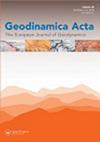库奇渐新世(印度西部)的Nummulitids、鳞翅目和Sr同位素数据,以及年代地层和古生物地理学评估
IF 1.5
Q1 Earth and Planetary Sciences
引用次数: 17
摘要
印度库奇(Kutch)渐新世浅海层序位于地中海和西太平洋之间,在古生物地理解释中具有重要意义。大型底栖有孔虫(LBF)是地中海浅底栖带(SBZ)与西太平洋“字母阶段”之间相关性的基本联系。通过对马尼亚拉堡组5个地层剖面的内部测试进行形态计量学研究,对LBF进行了重新评价。基于它们与地中海同期动物群的显著亲缘关系,在sr同位素地层学的支持下,它们被划为W Tethyan SBZ带。在基底段,我们发现了Nummulites bormidiensis、N. keskemetii和Heterostegina assilinoides,通常被认为是早鲁贝利世,并将其定位于早Chattian SBZ 22B带。珊瑚灰岩段,以前被认为是鲁伯利晚期,也被分配到这个区域,因为有N. bormidiensis, Eulepidina formosoides-dilatata和Nephrolepidina morgani-praemarginata。sr同位素数据进一步支持其早于沙世时代(26.5-29 Ma)。Bermoti段(组顶部)的miogypsinides planatus和Spiroclypeus margaritatus记录了晚夏世sbz23带,sr同位素数据(22.5 ~ 24 Ma)表明其接近渐新世-中新世界线。本文章由计算机程序翻译,如有差异,请以英文原文为准。
Nummulitids, lepidocyclinids and Sr-isotope data from the Oligocene of Kutch (western India) with chronostratigraphic and paleobiogeographic evaluations
Abstract Due to its intermediate geographical position between the Mediterranean and W Pacific, the Oligocene shallow-marine sequence of Kutch (India) is of key importance in paleobiogeographical interpretations. Larger benthic foraminifera (LBF) are a fundamental link for the correlation between the Mediterranean shallow benthic zones (SBZ) and the W Pacific ‘letter stages’. LBF were re-evaluated by morphometric studies of the internal test from five stratigraphic sections of the Maniyara Fort Formation. Based on their significant affinity to coeval fauna in the Mediterranean, they were assigned to W Tethyan SBZ zones, supported by Sr-isotope stratigraphy. In the Basal Member, traditionally considered as early Rupelian, we identified Nummulites bormidiensis, N. kecskemetii and Heterostegina assilinoides assigning it to the early Chattian SBZ 22B Zone. The Coral Limestone Member, previously considered as late Rupelian, is also assigned to this zone, for the presence of N. bormidiensis, Eulepidina formosoides-dilatata and Nephrolepidina morgani-praemarginata. Its early Chattian age (26.5–29 Ma) is further supported by Sr-isotope data. Miogypsinoides complanatus and Spiroclypeus margaritatus in the Bermoti Member (the top of the formation) document the late Chattian SBZ 23 Zone and the Sr-isotope data (22.5–24 Ma) place it close to the Oligocene–Miocene boundary.
求助全文
通过发布文献求助,成功后即可免费获取论文全文。
去求助
来源期刊

Geodinamica Acta
地学-地球科学综合
CiteScore
4.50
自引率
0.00%
发文量
0
审稿时长
25 weeks
期刊介绍:
Geodinamica Acta provides an international and interdisciplinary forum for the publication of results of recent research dealing with both internal and external geodynamics. Its aims to promote discussion between the various disciplines that work on the dynamics of the lithosphere and hydrosphere. There are no constraints over themes, provided the main thrust of the paper relates to Earth''s internal and external geodynamics. The Journal encourages the submission of papers in all fields of earth sciences, such as biostratigraphy, geochemistry, geochronology and thermochronology, geohazards and their societal impacts, geomorphology, geophysics, glaciology, igneous and metamorphic petrology, magmatism, marine geology, metamorphism, mineral-deposits and energy resources, mineralogy, orogeny, palaeoclimatology, palaeoecology, paleoceanograpgy, palaeontology, petroleum geology, sedimentology, seismology and earthquakes, stratigraphy, structural geology, surface processes, tectonics (neoteoctonic, plate tectonics, seismo-tectonics, Active tectonics) and volcanism.
Geodinamica Acta publishes high quality, peer-reviewed original and timely scientific papers, comprehensive review articles on hot topics of current interest, rapid communications relating to a significant advance in the earth sciences with broad interest, and discussions of papers that have already appeared in recent issues of the journal. Book reviews are also included. Submitted papers must have international appeal and regional implications; they should present work that would be of interest to many different specialists. Geographic coverage is global and work on any part of the world is considered. The Journal also publishes thematic sets of papers on topical aspects of earth sciences or special issues of selected papers from conferences.
 求助内容:
求助内容: 应助结果提醒方式:
应助结果提醒方式:


